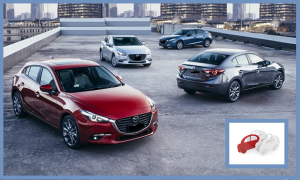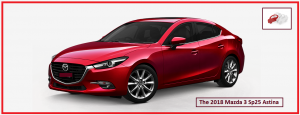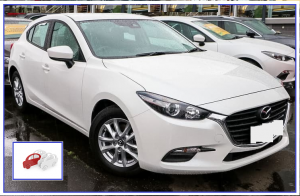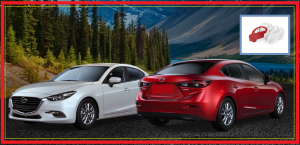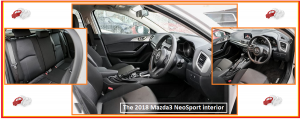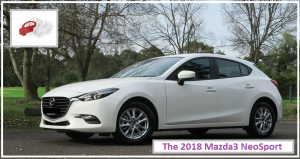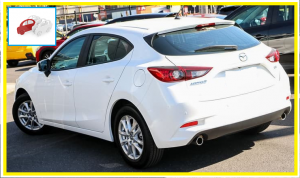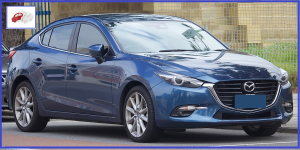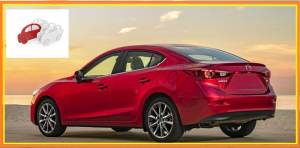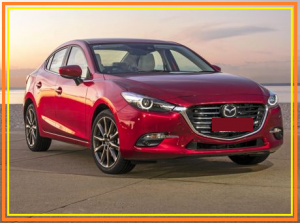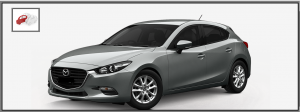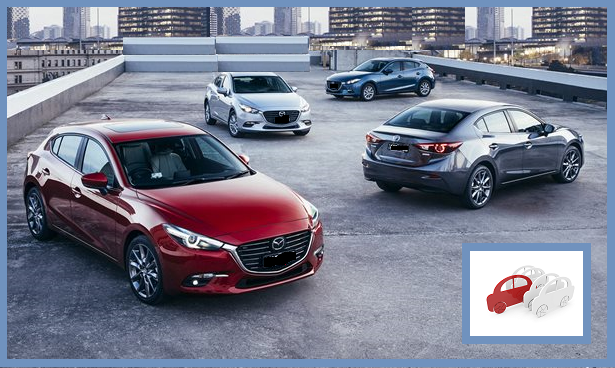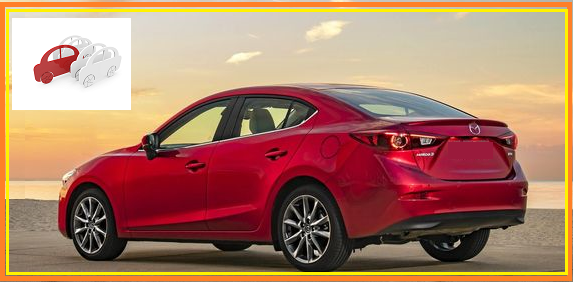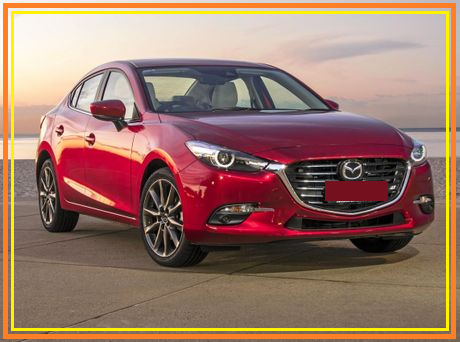DABAS Blog post: Late October 2018,
Focus on: The 2018 upgraded Mazda 3 range;
Hello readers, at DABAS, we often have enquiries from clients wanting to buy a small- to medium-sized brand-new passenger car for their A-to-B daily commute around Melbourne, with an entry-level RRP starting price of under $25,000 – so, in this DABAS blog post let’s have a “very brief generalised-in-nature look” at a car that fits these criteria: the recently upgraded 2018 Mazda3 range, available now at a local Melbourne Mazda dealership near you. We hope you find it an interesting read whilst shining some light on this popular model range, providing some useful “very general-in-nature” information to help you on your car-selection and car-buying journey.
If you would like DABAS’s assistance buying a car, please click here.
Here we go
To start with: some trivia for the car enthusiasts: The first series of Mazda3 arrived in 2004; back then it was the second passenger vehicle in Mazda’s range to move away from Mazda’s previous triple-number naming scheme with its evolution of the model to the Mazda 3 (which replaced the Mazda 323), ending a quarter-century run for the Mazda 323. The Mazda 3 was more than good enough to carry the number forward. Mazda’s small-sized sedan and hatch were competing with the Corolla and similar model cars; it was always going to be a difficult job, but the Mazda 3’s combination of reported handling prowess, good design, smart looks and high level of standard inclusions have made it a continued sales success, including this current general platform design launched in 2013, which has continued to this current Mazda3 BN series model, upgraded once again earlier in 2018. A regularly asked question is whether the ‘SkyActiv’ engine uses a timing belt or chain: the engines are both chain-driven. Where is the Mazda3 built? generally, all Australian Mazda 3s come from Mazda’s Japanese factories. The Mazda 3 vehicle is also known as Mazda Axela in Japan and China. Earlier series generations of the Mazda3 shared platforms and some running gear with Ford and Volvo cars – hence being related – to small cars like the Ford Focus and the Volvo V40.
The upgraded 2018 Mazda3 is not a massive upgrade to the previous MY17 range; a few minor updates make Mazda’s attractive small car that little bit more appealing to October 2018’s brand-new car buyers in this very competitive size and price range variant segment. There are two newly named specification levels: the entry-level NeoSport and the next step up the ladder, the Maxx Sport. Some great news is that a reversing camera and AEB are now standard across the entire range; it seems a subtle but measured response to other segment competitors like the Hyundai i30 and the recently released in August 2018 My19 Toyota Corolla; just to name a few.
The Mazda3 range variants RRP price list start at $21,490 plus ORC continuing through to $35,490 plus ORC. Spanning the five models in the range are two engines and two transmissions. The pricing is the same whether you choose the sedan or hatch variant.
All Mazda3s are now front-wheel drive. It’s been a while since Mazda sold an RWD or AWD car at this level. Of course, if you are set on a 4WD Mazda, you’re spoilt for choice with the small CX-3 and mid-size CX-5, or the 7-seater CX-9. If you want a turbodiesel Mazda, your Mazda choice of offerings in 2018 is the Mazda passenger-car segment is the new 2018 Mazda CX-8.
With the NeoSport upgrade, Mazda’s full infotainment system is on all 3s. It has great usability, with touchscreen when you’re stopped and a rotary dial with shortcut buttons for when you’re on the move. ‘MZD Connect’ also powers the GPS navigation system (where fitted). The USB port will handle your iPhone or Android phone; MP3-compatible devices also. Up to the SP25, the sound system features six speakers. The GT and Astina each feature nine Bose-branded speakers, including a subwoofer. There is no ‘radio CD player’, DVD player, or CD changer available anymore and you can’t get Android Auto or Apple CarPlay.
Since the early 2018 upgrade there are now five trim levels, two of them newly renamed. The entry-level machine is now called the NeoSport to reflect the bump in specification over the 2017 base model, starting at $21,490 for the six-speed manual transmission, or $23,490 for the automatic transmission. (The MY18 price is up by $1000 in comparison to the MY17 base model Mazda 3). Included in the NeoSport are standard features such as 16-inch alloy wheels, trip computer, air conditioning, push-button start, electric power steering, central locking, projector-style halogen headlights, rear parking sensors, reverse camera (new to the entry level) – along with standard AEB, a 7.0-inch MZD Connect touch screen, cruise control, lightly tinted windows, automatic door lock, a power window in each door and mirrors and a space-saver spare tyre.
The Maxx Sport builds on the NeoSport’s spec and is also a new badge to the range. Priced from $23,490 for the manual and $25,490 for the auto, you get the same size rims, but you pick up dual-zone climate control, rain-sensing wipers, leather steering wheel, auto headlights, electronic park brake (replacing the manual park brake), gear-shift paddles, the first appearance of sat nav and additional safety features in the form of reverse AEB, blind-spot monitoring and rear cross-traffic alert.
The last of the cars with 2.0-litre power is the Touring. The Touring starts at $25,490 for the manual and $27,490 for the auto; the Touring picks up leather seats and keyless entry and keyless start (smart key).
The 2.5-litre engine powered range starts with the SP25, with the manual starting at $25,990 and the auto $27,990. The SP25’s spec is in- between the 2.0-litre Maxx Sport and Touring, but you get LED headlights, 18-inch alloy wheels, twin exhausts and nice cloth trim.
The GT SP25 costs $29,990 for the manual or $31,990 for the automatic; included are leather seats, heated folding mirrors, adaptive front lighting system, traffic-sign recognition and driver-attention detection. The sound system is the earlier mentioned BOSE nine-speaker system, and the dash gets a funky colour screen between the dials.
The top of the range is the SP25 Astina, starting at $33,490 for the manual and $35,490 for the auto. The SP25 Astina includes all that the GT has but ups the included offerings with plenty of safety gadget acronyms. In addition to the sunroof, forward collision warning, lane-keep assist, lane-departure warning, active cruise control and rear light LED. The bright finish 18-inch alloys and LED daytime running lights complete the picture. There is also a the ‘Kuroi Sport Pack’ body kit, which adds side skirts, a front spoiler and a very modest rear diffuser, while keeping the rear wing spoiler. The extensive accessories list includes alloy pedals, cargo liner, floor mats, cargo tray roof-rack kit, tow bar and welcome lighting, heated steering wheel, homelink, HID or bi-xenon headlights, panoramic sunroof, driving lights, roof rails, bull bar, nudge bar, seatbelt extender, sport exhaust system, red brake calipers, performance brakes, chrome wheels, limited-slip differential or a luxury pack option. No Australian delivered Mazda 3 comes with a full-size spare wheel,
The 3’s exterior design is based on Mazda’s Kodo design principle; it looks great in just about any colour and Mazda’s commitment to creating beautiful paint-layering systems with sparkling Santa tinsel-like dazzling colours some years ago is paying dividends. The Mazda 3 is a flowing design that some reviewers say looks best in the sedan-body style, and currently few cars in the segment are as pretty. As you climb the Mazda 3 levels, the detailing in items like the lights and brightwork mark out the spec level, with additions like chrome exhaust tips and LED daytime running lights.
The Mazda 3 range is available in seven colours: ‘Sonic Silver’, ‘Jet Black’, ‘Deep Crystal Blue’, ‘Titanium Flash’ (bronzey brown), ‘Snowflake White’ and ‘Eternal Blue’. Mazda offers those colours as no-cost options. ‘Machine Grey’ and ‘Soul Red Crystal’ (this one is awesome) are an added expense, although still reasonable at $300 extra.
The Mazda 3 comes in two body styles: four-door sedan and five-door hatchback. The most popular is the shorter hatch, despite the loss of luggage capacity. The different boot space dimensions deliver 308 litres in the hatch while the sedan has 408 litres. For load capacity, the sedan has the best luggage capacity. The hatch’s boot size isn’t exactly huge, but it does feature a cargo cover to hide your valuables.
The interior dimensions are unchanged, meaning great rear legroom. The cabins are basically the same as the 2017 models, with only very minor differences. The coffee cup-holder count varies depending on which variant you choose. The NeoSport has just two, for the front passengers. In the rest of the range there are two up front and two in the rear, with bottle holders in each door as backups. Some Mazda 3 variants feature extra storage space for books or devices but there’s no sunglasses holder until you reach the Touring. The turning circle is a standard 10.6 metres, so most suburban streets need a three-point-turn manoeuvre. Park assist is limited to beepers and the reversing camera. Ground clearance when unladen is 160mm. Kerb weights range from 1258kg for a Mazda3 manual Neo to 1336kg for an automatic Astina; The Mazda 3’s gross vehicle weight ranges from 1800kg to 1875kg. There are two engine specs in the 3 range; both are equipped with Mazda’s ‘i-Stop’ stop-start technology but go without the Mazda 6’s ‘i-Eloop’ regenerative braking battery-charging tech. Every model comes with a choice of gearbox, either a six-speed manual or six-speed automatic. The automatic is a traditional auto rather than the dual-clutch or CVT you might find in some segment rivals. Both engines run on standard unleaded and use a standard oil type. As mentioned earlier, a regularly asked question is whether the ‘SkyActiv’ engine uses a timing belt or chain: the engines are both chain-driven. The NeoSport, Maxx Sport and Touring all come with the 2.0-litre SkyActiv with 114kW and 200Nm of torque. The SP25, SP25 GT and SP25 Astina are, as the name suggests, equipped with the larger 2.5-litre motor that pumps out 138kW (nearly exactly 200 brake horsepower) and 250Nm. Towing capacity is rated at 1200kg braked and 600kg unbraked regardless of engine size. The diesel vs petrol argument has long since been settled with the demise of – the reportedly – not particularly popular previous Mazda 3 Diesel variant. So, you don’t have to worry about the expense of a diesel particulate filter replacement any more. There is no LPG or turbo sport edition, like the old MPS3 performance car. Performance figures vary between the two engines: the SP25 auto should complete the 0-100km/h acceleration test in just under eight seconds, with the 2.0-litre in around nine seconds. The manuals will likely be slightly slower. Diesel-engine problems are clearly a thing of the past, with no diesel now being offered. – Fuel-consumption figures vary slightly between the models; reported figures suggest that the 2.0-litre burns petrol at 5.8L/100km for the auto and 5.9L/100km for the manual, while the 2.5-litre consumes 6.1L/100km for the auto and 6.5L/100km for the manual. Your daily school-run and real-world driving figures may vary. Fuel-tank capacity is 51 litres, regardless of engine size, and there’s no need for premium fuel.
Safety: Some of the Mazda 3’s great things to note are the availability of AEB across the range, and that a reversing camera has now been added as well. All cars come with a minimum suite of safety features, comprising six airbags (including side airbags), anti-lock brakes (or ABS), electronic stability control (aka DSC), a clever traction-control system, emergency brake assist and hill-start assist.
As you go up the Mazda 3 variant range, you’ll see additions such as traffic-sign recognition, blind-spot monitoring, lane-departure warning, rear cross-traffic alert with reverse AEB, forward collision warning and lane assist, (to see what all those safety acronyms mean and do, please click here) There are three top-tether baby-seat anchor points while your ISOFIX car seat can go in a choice of two points. Regardless of your chosen variant’s specification, the Mazda3 scored a five-star ANCAP safety rating in August 2016.
Some points to note: the previous BM, BN series model Mazda 3 variants have reportedly enjoyed good resale value, with a quick web check suggesting a well-looked-after (full service history)and no-accident history example of a 2014 Neo, with a RWC, will when re-sold recoup an estimated 60per-cent of original purchase price from when brand new, at private sale, hinting that you’ll have few issues when you sell a well-maintained second-hand Mazda3. Reportedly, over the years, Mazdas in general have suffered from poor insulation, resulting in road noise invading the cabin space. Research suggests things have gotten better and continue to do so. Where in the past, occupants reportedly endured tyre and suspension noise, especially from the front, reviewers say that’s no longer a problem.
Warranty: For Mazda vehicles purchased on or after 1st August 2018, it is now 5 years and unlimited kilometres; for more information on the new Mazda 5-year warranty go to the Mazda Australian website link below
https://www.mazda.com.au/owners/warranty/new-vehicle-warranty-terms-and-conditions/
Those worried about service costs will be pleased to know Mazda offers capped-price servicing. Your Mazda authorised mechanic expects to see you every 10,000km or 12 months, whichever comes first; the capped-price service prices are listed on the Mazda website, varying very slightly between the Mazda3’s engine types.
(Psst- Note: Within the top 10 companies selling cars in Australia, only Toyota, and two other brands – Nissan and Volkswagen – continue to offer warranty coverage limited to three years).
To Summarise: The Mazda 3 range is a series of popular cars in their segment and continues to improve with every upgrade. The recent 2018 uplift in the NeoSport with having a proper screen and reversing camera – along with standard AEB – starts to make the minor extra expense over the previous model well worth it. Reviews say the Maxx Sport is the Mazda3 variant to go for – as it has a good package of safety equipment and a sensible specification list for the RRP price. Some do say the Mazda3 is one of the best-looking cars in the segment. The new Hyundai i30 and recently launched new Toyota Corolla are “some of” the Mazda3’s main rivals these days, especially in price and specification levels, with the Kia Cerato range rapidly closing in as it gets the 2018 MY19 series updates, (with an all-new updated MY19 Kia Cerato hatch only a very short time away).
At DABAS we know that buying a car to suit your needs can be one of the biggest purchases in your life; we hope this intended to be “general-in-nature advice and information” blog page has provided some helpful assistance for you in deciding the path of your car-buying journey. We look forward to having a chat when the need arises for you to update your car; to assess your personal car-safety requirements and buying needs to suit your lifestyle. And importantly your set specified budget!
Whatever roads your life journey takes you on, DABAS can help you find a car to travel those roads.
Please note: Examples, options, pricing and information mentioned in this blog post is to be considered as a very general-in-nature summary; all specifications, pricing mentioned in this blog page may be outdated or superseded by your time of reading this blog page, all information and pricing will be negotiated and confirmed at the time of you updating into your brand-new Mazda3, together with your chosen new vehicle’s sales representative in their Mazda showroom at the time you transition to becoming a client of DABAS.
DABAS is aware of some things to consider and to be aware of when updating, trading in or privately selling your old car, including the special trade-in incentives offered on drive-away-no-more-to-pay deals obtainable – at times – within leading brands’ Melbourne brand-new car dealerships.
These will be discussed upon your transition to becoming a client of DABAS.
To contact DABAS to discuss your car-buying needs, please click here
To see some interesting things to consider when buying a car, please click here
To see 3 things to consider when moving on your old car, please click here
For a step-by-step example of a DABAS car-buying journey, please click here
Some interesting past articles and information on safety acronyms , please click here
Thanks for visiting The DABAS website and blog: Have a great day, Cheers, Tim.


